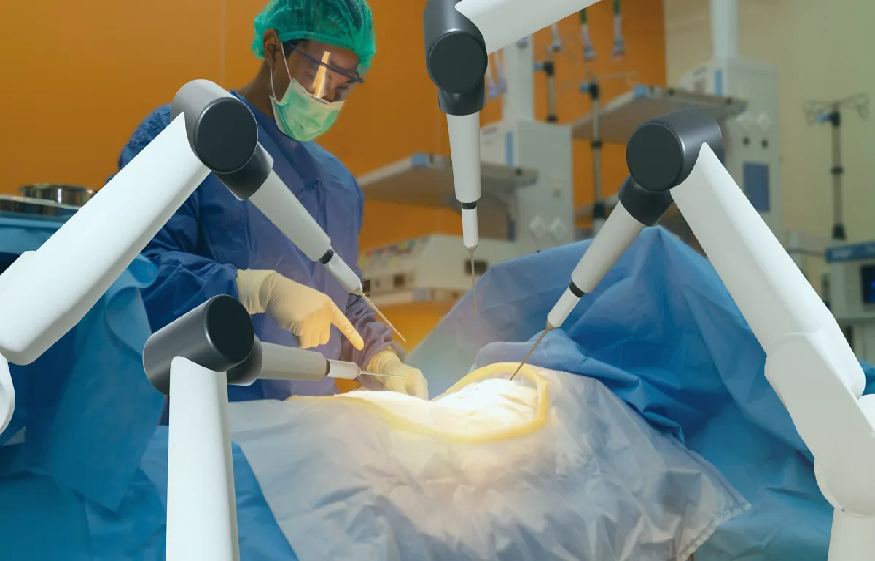Robotic-assisted surgery has been gaining traction across various medical fields, and spinal fusion is no exception. As surgical techniques advance, the integration of robotic systems in spinal fusion surgeries plays a pivotal role in enhancing precision, reducing risks and minimizing human error. Dr. Larry Davidson, a leading expert in spinal surgery,highlights that for patients undergoing spinal fusion, these advancements can support better outcomes, potentially faster recovery times and a reduced likelihood of postoperative complications.
The Role of Robotics in Spinal Fusion
Spinal fusion is a complex procedure aimed at permanently connecting two or more vertebrae to stabilize the spine, often necessary to treat conditions like degenerative disc disease, scoliosis, or spinal fractures. One of the biggest challenges in spinal fusion is the precise placement of screws, rods, or other hardware to ensure proper alignment and stability. Even slight misalignment can lead to complications such as nerve damage, improper fusion, or the need for revision surgery.
Robotic systems like Mazor X and ExcelsiusGPS are specifically designed to assist surgeons in placing these implants with greater accuracy. These robotic systems work by using preoperative imaging, such as CT scans, to create a 3D map of the patient’s spine. This map serves as a guide throughout the surgery, enabling the robotic arm to assist the surgeon in precisely positioning the implants.
By following this digital blueprint, robotic systems enhance the surgeon’s ability to navigate the complexities of spinal anatomy, ensuring that each screw or rod is placed with pinpoint accuracy. This precision significantly reduces the risk of implant-related complications, ensuring a higher success rate for spinal fusion procedures.
Increasing Accuracy with Robotic Assistance
One of the main benefits of robotic systems in spinal fusion is their ability to increase the accuracy of implant placement. Traditional spinal surgeries rely on the surgeon’s skill, experience and manual dexterity to position implants, which can be challenging due to the intricacies of spinal anatomy. Even the most experienced surgeon is subject to the limitations of human error, and minor deviations can have significant consequences for the patient’s outcome.
Robotics, on the other hand, offer a level of precision that surpasses human capabilities. Using real-time imaging and advanced software, robotic systems provide continuous guidance, helping the surgeon achieve the optimal placement for each implant. With the assistance of these systems, surgeons can ensure that the hardware is positioned exactly where it needs to be, minimizing the risk of misalignment or other complications.
In addition to improving the accuracy of screw and rod placement, robotic systems also allow for smaller incisions, which leads to less damage to surrounding tissue. This not only reduces postoperative pain but also contributes to faster recovery times and shorter hospital stays for patients.
Minimizing Human Error in Spinal Fusion Surgery
One of the most significant advantages of robotic-assisted surgery is its ability to minimize human error. Even the most skilled surgeon can experience fatigue or distractions during lengthy procedures, increasing the risk of mistakes. Robotic systems provide a level of consistency and precision that mitigates these risks. In spinal fusion surgeries, the integration of robotics ensures that each step is guided by preoperative planning and real-time feedback, allowing surgeons to remain in control while benefiting from the robotic system’s added accuracy. By following the pre-programmed surgical plan, the system executes delicate tasks with steadiness and precision that would be difficult to achieve manually. This consistency not only helps to minimize errors but also supports improved surgical outcomes and can enhance safety for patients. Robotics allow surgeons to perform with more confidence, knowing the system provides real-time feedback and ensures everything proceeds according to the precise plan.
Reducing Surgical Risks with Robotics
Robotic-assisted spinal fusion surgeries can help reduce risks commonly associated with traditional procedures, particularly the potential for damage to surrounding nerves and tissues during the placement of screws or rods. Any miscalculation in traditional surgery can lead to nerve damage, excessive bleeding, or improper spinal alignment, all of which can cause serious complications. Robotics help mitigate these risks by providing surgeons with real-time, detailed imaging of the patient’s spine, allowing for precise navigation and reducing the likelihood of harming critical structures. Additionally, robotic systems enable smaller incisions, resulting in less muscle and soft tissue damage, which lowers the risk of infection, reduces blood loss and promotes a quicker, more comfortable recovery for patients.
Shorter Recovery Times and Better Outcomes
The benefits of robotic-assisted spinal fusion go beyond the operating room. Because robotic systems enable more precise and less invasive surgeries, patients often experience shorter recovery times compared to those who undergo traditional spinal fusion procedures. Minimally invasive techniques facilitated by robotics can lead to less postoperative pain, reduced scarring and a quicker return to normal activities for patients.
Additionally, robotic systems’ increased accuracy means that patients are less likely to experience complications such as implant failure or improper fusion, which could require further surgeries. In fact, studies have shown that robotic-assisted spinal surgeries have lower revision rates compared to traditional methods, indicating a higher success rate and long-term stability for patients.
The Future of Robotic-Assisted Spinal Surgery
As robotic technology continues to advance, the future of spinal fusion surgeries looks promising, with current systems like Mazor X and ExcelsiusGPS already demonstrating their effectiveness in improving precision and reducing risks. However, further advancements are on the horizon, particularly the integration of artificial intelligence (AI) with robotic systems. AI has the potential to enhance surgical planning by analyzing data from past surgeries and patient outcomes, offering surgeons insights into the best approaches for each patient, leading to more personalized treatment plans and better outcomes for complex spinal conditions. Additionally, the development of smaller, more versatile robotic systems could further reduce the invasiveness of spinal fusion surgeries, making procedures safer and more efficient, with even better results for patients.
The integration of robotics in spinal fusion surgery is transforming the field, offering increased accuracy and reducing the risks associated with traditional surgical methods. Dr. Larry Davidson mentions that by enhancing precision, minimizing human error and enabling minimally invasive techniques, robotic-assisted surgeries can help support better outcomes and shorter recovery times. As technology continues to evolve, robotic systems are set to play an even greater role in the future of spinal surgery, offering safer, more personalized care for patients with spinal conditions.



